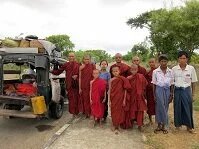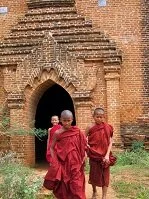Culture & Identity of Myanmar
Introduction

Monks in Bagan
Many countries in this world have lost numerous aspects of their culture and traditional way of life due to advancements in communication, technology, transportation, and globalization. However, Myanmar has been essentially sealed off to foreigners for years so these outside influences have only begun to arrive. These influences are arriving quickly though and the country has been in a constant state of change for the past few years and these changes will likely continue into the foreseeable future.

Children Monks
Yangon, the country's former capital is already beginning to look and feel like a modern world city, but hidden around many corners is the traditional culture and way of life, often times in complete contrast to that of modern society, such as a pagoda (Sula Pagoda) from thousands of years ago standing in the middle of a busy traffic round-about.
However Yangon may appear to the visitor, this city symbolizes the future of the country more than it represents the majority of the present day country. Most of the people in the country live in rural areas and 70% of the working population is still employed in agriculture. This way of life is what most of the Myanmarese know and this is the root of the culture.
Being isolated for so many years, many of the people in Myanmar know nothing more than this agricultural life. In these towns, villages, and fields life is based on the sun, the weather, and the seasons. But work is difficult, especially considering few farmers have modern equipment. This has led to a reliance on family and neighbors for work, building houses, and anything else that must be done throughout the year. Additionally, as communicate and transportation in many areas is lacking now and in the past, these communities were the center of the world for most people and even today local community is much more important than nation, or really anything else.